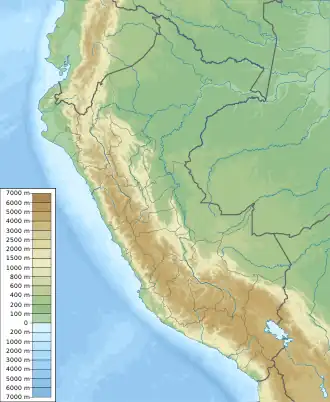| Auquihuato | |
|---|---|
 The cinder cone at the margin of the light-colored plateau just below the center of this NASA Landsat image (with north to the top) is Auquihuato. | |
| Highest point | |
| Elevation | 4,980 m (16,340 ft)[1] |
| Listing | Volcanoes of Peru |
| Coordinates | 15°04′30″S 73°11′26″W / 15.07500°S 73.19056°W |
| Geography | |
 Auquihuato Peru | |
| Location | Ayacucho Region, Peru |
| Parent range | Andes |
| Geology | |
| Mountain type | Cinder cone |
Auquihuato[1][2] (possibly from Quechua, awki: prince, watu: prediction, fortuneteller)[3][4] is a cinder cone in the Andes of Peru, 4,980 metres (16,339 ft) high.[1] It is situated in the Ayacucho Region, Paucar del Sara Sara Province, on the border of the districts Colta and Oyolo.[5] Auquihuato lies northeast of Sara Sara volcano.[2]
Geology
Context
Auquihuato is surrounded by a Pliocene volcanic plateau,[6] the cone formed on the plateau's southern margin. Sara Sara lies 30 kilometres (19 mi) southwest,[1] and Firura lies 10 kilometres (6.2 mi) farther east. Auquihuato lies east of the main volcanic arc and is aligned with several other volcanic centres in a northwest-southeast line.[7]
Volcano
Auquihuato is c. 400 metres (1,300 ft) high and a lava flow extends southward from the cone, reaching a length of 12 kilometres (7.5 mi). The lava flow has a pahoehoe texture[6] and a thickness of 50 metres (160 ft).[8] It has well developed levees.[1]
Activity
The stratovolcano developed during the Pleistocene and Holocene.[8] The noticeable lava flow is of Holocene age[6] but no radiometric dating is available[6] and no historical eruptions are known. The Geophysical Institute of Peru began to monitor the geodesy of the system in 2019[8] and it is considered a low-hazard volcano.[9]
Ground deformation has been observed by InSAR observation, centered 7 kilometres (4.3 mi) southeast of Auquihuato and with a circular shape. The ground deformation may be caused by changes in the pressure within the volcano's magma system, at depths probably exceeding 1 kilometre (0.62 mi), but an origin in a hydrothermal system is also possible.[6] Volcano-tectonic earthquakes have been recorded.[8]
References
- 1 2 3 4 5 "Cerro Auquihuato". Global Volcanism Program. Smithsonian Institution. Retrieved 17 June 2023.
- 1 2 Peru 1:100 000, Pausa (31-p). IGN (Instituto Geográfico Nacional - Perú).
- ↑ Teofilo Laime Ajacopa, Diccionario Bilingüe Iskay simipi yuyayk'ancha, La Paz, 2007 (Quechua-Spanish dictionary): awki. - s. Príncipe. Hijo de un ser superior o de un rey. watu. - s. Cordón. Cuerda delgada. watuq, wamuni, umu.. - s. Adivino. Persona que adivina. || fig. Hechicero, brujo. Layqa.
- ↑ Diccionario Quechua - Español - Quechua, Academía Mayor de la Lengua Quechua, Gobierno Regional Cusco, Cusco 2005: awki - s. Mit. En la mitología inkaica y la actual andina, man o espíritu protector, personaje mítico que habita en las altas cumbres, ser protector encamado en los montes, el alma de los cerros elevados. Generalmente se usa en plural: awkikuna, espíritus protectores. SINÓN: apucha, machula. || Príncipe, hijo del Inka. || Abuelo. watu - - s. Augurio, pronóstico, predicción, vaticinio, presagio. Ec: huatu. || Cordón, pita, cuerda, hilo retorcido. || Cinturón, correa.
- ↑ escale.minedu.gob.pe - UGEL Map of the Paucar del Sara Sara Province (Ayacucho Region)
- 1 2 3 4 5 Morales Rivera, Anieri M.; Amelung, Falk; Mothes, Patricia (July 2016). "Volcano deformation survey over the Northern and Central Andes with ALOS InSAR time series". Geochemistry, Geophysics, Geosystems. 17 (7): 2869–2883. doi:10.1002/2016GC006393.
- ↑ de Silva, SL; Francis, PW (March 1990). "Potentially active volcanoes of Peru-Observations using Landsat Thematic Mapper and Space Shuttle imagery". Bulletin of Volcanology. 52 (4): 286–301. doi:10.1007/BF00304100. S2CID 140559785.
- 1 2 3 4 Centeno Quico, Riky; Rivera, Marco (April 2020). "Reconocimiento automático de señales sísmicas de origen volcánico para la alerta temprana de erupciones volcánicas del sur del Perú".
- ↑ Sur, Instituto Geofísico del Perú Observatorio Vulcanológico del (December 2017). "Investigación y monitoreo de volcanes activos en el sur del Perú. Reporte técnico especial 2017".